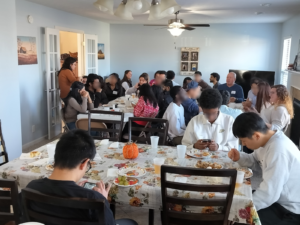So, there’s a pandemic. Your campus is shutting down, moving all student classwork to online formats. You have a weekly meeting that is the heartbeat of your ministry. What do you do? Well, maybe for you the answer is to go digital and have a virtual meeting, after all “For everything there is a season, and a time for every matter under heaven” (Ecc. 3:1 ESV). The truth is, this might be a hard season, but don’t lose faith.
“If we cannot believe God when circumstances seem be against us, we do not believe Him at all”.
– Charles Spurgeon
So if you decide to give virtual meetings a go, here are some ideas that might help:
It can’t be the same. Embrace this.
No matter what you do, you cannot recreate the physical face-to-face environment you have carefully created and cultivated at your weekly meetings. The lack of welcoming greeters, cool ambiance, singing together to live worship music, and the ability to easily socialize with dozens of friendly people cannot be replicated in an online platform. You can at best provide shadows of the real thing. That said, to offset this loss you can play to the strengths current technology allows. The best example I can think of is how the Hebrew people did not abandon the entirety of their faith once the temple was destroyed and they were hauled off into captivity. There was loss of the temple worship system, yet the faith remained. The faithful gathered in small clusters and worshipped, teaching each other, and passing the faith along to the next generation. The Greeks later called these innovative Jewish worship centers synagogues, coming from a root word which means “to bring together”. It may not be perfect or what you had before, but don’t think you can’t bring people together even without your old meeting format.
Play to the strengths of the technology.
You can totally stream a meeting, probably for free. Zoom, Skype, Google Hangouts, and other platforms all allow you to do stream for free. However, there are some limitations, typically in the number of people who can join the meeting or in the time limit allowed for live streaming. Paid plans are available with these platforms and many others, you’ll just need to count the cost. (Currently, I prefer Zoom and I use it almost daily.) Most of these systems have the ability to easily record these streams and share them with those who couldn’t join in. Take advantage of this, host the videos on YouTube, and post these to your social media pages.
Many, if not most, of your students are already well-versed in distance learning. A majority of college students will have taken at least one fully online class. Many more take blended classes that mix face-to-face interactions with asynchronous online work. My point is, this learning modality is not entirely new to them, and it will be a ubiquitous feature in their future workplace. So changing your method of meeting isn’t as much of a strange experience for your group as many might think.
Guest Speakers: Since you are already streaming, you can get guest speakers without having to have them with you physically. This opens the door to lots of great people for your students to hear from and can make what seemed like a poor substitution of a regular meeting into something more special. Think through who you’d like your students to hear from and interact with, whether it is great ministry leaders from around the country, missionaries, or seminary professors.
You can share your computer screen on most video streaming platforms, so showing slides and other media is easy. Don’t just show one screen the whole time, mix it up. Bounce back and forth between our media content and the video of the presenter speaking.
Adjust for the weaknesses of the technology.
If you can’t afford the cost of a paid plan for video casting, then you might need to shorten your meeting to fit the time frame. You also probably can’t do group discussion easily, but you can use the chat feature most platforms offer. Students can ask questions while the presenter is talking and then you can go through those questions at breakpoints or at the end. By the way, you can have someone moderating the chat while you speak so you aren’t distracted. You’ll need a good camera (or webcam), as well as a decent microphone to capture audio. Because the audio may be weaker, you might need to slow down your speaking style just a little and try to speak more clearly than you would in a live meeting. Don’t worry about the band, give your worship leader(s) a break. Most students will be listening via their weak Mac Book speakers, so the band probably wouldn’t sound good even if you managed to pull it off! Whatever you do, keep the Word at the heart of your meeting, centering it on scripture.
“The world changes – circumstances change, we change – but God’s Word never changes”
– Warren Wiersbe
Innovate.
Consider the “flipped classroom” model, wherein students consume some material (meditate on some scripture, watch a David Platt video, read a Paul Worcester Article, listen to a Gospel Coalition Podcast, etc.) before they join the meeting. That way, the meeting time can be less data transfer via a speaker and more analysis and application by a shepherd.
Take a passage of scripture and use a virtual whiteboard (I’d suggest Miro) to screencast your breakdown of the passage like John Piper does in his web series “Look at the Book.” There are a myriad of tools out there, you just have to find them and play around with them.
Use the time you’d spend on things like worship to do other digital projects that equip and enrich. Example: Your worship leader(s) could pick some of their favorite songs, talk about them and show how they arise out of scripture, and then do a cover of that song on a podcast. (Just make sure you have an up to date CCLI license before recording any music).
You could Interview alumni and have them share about how they are applying the things they learned in college to their walk with Christ today. Pick those who are continuing to live out your ministry’s values and who represent the types of majors your group is comprised of.
This could be a good time to work with other campus ministries and creatively do some things together.
Follow wise practices for good streaming.
Remove distractions and ambient noise. This may mean recording using your local church, office, etc. You might want to try to avoid recording at home unless you need to, especially if you have kids. Remember, if it’s just you and a laptop they can hear every breath you take and every click of the mouse or keyboard. For short videos just to connect with students, this is fine. However if you want a quality virtual meeting experience, you need to put some time and energy into making this right.
Use a decent camera and microphone, and have broadband internet. You can use Wi-Fi, but consider linking directly to your router to avoid lag or choppiness of the video and audio. Elevate the camera so they can see you. Don’t just sit directly in front of your laptop. Try to go for a framing that’s similar to how a news anchor or weatherman might appear.
Do something to create interactivity. Use the chat feature for questions, prayer requests, etc. or have the students text in or use a hashtag on your social media streams. Mute everyone’s microphones until you ask a question, then let students speak up. If your group is small enough you can leave everyone’s mics on and even set Zoom to switch the video to whoever is talking.
Here are some more “best practices”: Orient yourself to the platform. Experiment with it. Read the how-to guide(s). Try it out with a fellow staff member before it is time to stream. Work out the kinks before you have the meeting. Start simple, add complexity as you learn.
Get the word out.
Post a link to the meeting in your social media, copy and send it out in mass text, maybe even do one of those old-school emails. Encourage leaders to invite. Update your website. Make a new hashtag. Start posting pics
promoting on Instagram as soon as possible. Do a weekly giveaway with a random “door” prize for those who stream in (Amazon gift cards can be sent via email or text). You can expect your numbers to drop, but they don’t have to crater. You will need to do more promo for this than your regular meeting to see results.
Have some fun!
It may not be the meeting you want or the finale to the ministry season you’d hoped for, but don’t let it take you out of the game. Continue the work, making adjustments as needed. Try new things and have some fun, especially if you work on a team. It can be pretty fun to try some old-school pedagogies on new platforms using today’s technology (Just don’t stream flannel-graph and puppetry!). Be flexible, knowing God can and will give you what you need to continue the work for his glory. Don’t think the lack of a live weekly meeting means your spirit must be crushed. Listen to Paul when he says “I know how to be brought low, and I know how to abound. In any and every circumstance, I have learned the secret of facing plenty and hunger, abundance and need.” (Phil 4:12 ESV).






